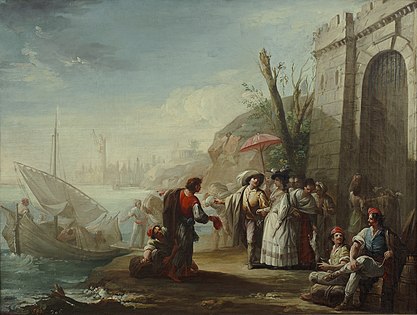Mariano Salvador Maella

Mariano Salvador Maella Pérez (21 August 1739 – 10 May 1819) was a Spanish painter known primarily for his portraits and religious frescoes. He was appointed chamber painter of King Charles IV of Spain in 1774 and became well known for his portraits.
Biography
Maella was born in Valencia. His artistic education began with his father, who was also a painter. In 1752, at the age of eleven, he moved to Madrid and received lessons from Felipe de Castro, a sculptor who helped introduce the Neoclassical style to Spain.[1] This was followed by enrollment at the Real Academia de Bellas Artes de San Fernando, where he attracted the attention of Antonio González Velázquez (whose daughter he would later marry).
In 1757, with the money from three prizes awarded by the Academia and the support of his family, he was able to study in Rome. He returned to Spain in 1765 and participated in the remodeling of the
His career in Madrid began in earnest when he was appointed a
In 1799, he and
Selected paintings
-
Saint Francis of AssisiReceiving the Stigmata
-
KingOrder
-
Queen Carlota Joaquina
-
The Embarcation
References
- ^ a b c d e Brief biography @ the Museo del Prado.
- ^ a b Brief biography @ MCN Biografías.
Further reading
- José Manuel de la Mano, Mariano Salvador Maella, 1739-1819: dibujos : catálogo razonado, Fundación Botín, 2011, 2 vols. ISBN 84-966558-7-3
- José Luis Morales y Marín, Mariano Salvador Maella: vida y obra, Moncayo, 1996 ISBN 84-7675-026-9
External links
- More works by Maella @ the Biblioteca Digital Hispánica
- "Mariano Salvador Maella en el reinado de Carlos IV. Apuntes Biográficos" by José Luis Morales y Marín from the Boletín de la Real Academia de Bellas Artes de San Fernando #69, 1989, digitalized @ the Biblioteca Virtual Miguel de Cervantes
- "Mariano Salvador Maella" scholarly articles both in web and PDF @ the Spanish Old Masters Gallery





